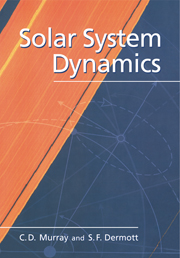Book contents
- Frontmatter
- Contents
- Preface
- 1 Structure of the Solar System
- 2 The Two-Body Problem
- 3 The Restricted Three-Body Problem
- 4 Tides, Rotation, and Shape
- 5 Spin–Orbit Coupling
- 6 The Disturbing Function
- 7 Secular Perturbations
- 8 Resonant Perturbations
- 9 Chaos and Long-Term Evolution
- 10 Planetary Rings
- Appendix A Solar System Data
- Appendix B Expansion of the Disturbing Function
- References
- Index
10 - Planetary Rings
Published online by Cambridge University Press: 05 June 2012
- Frontmatter
- Contents
- Preface
- 1 Structure of the Solar System
- 2 The Two-Body Problem
- 3 The Restricted Three-Body Problem
- 4 Tides, Rotation, and Shape
- 5 Spin–Orbit Coupling
- 6 The Disturbing Function
- 7 Secular Perturbations
- 8 Resonant Perturbations
- 9 Chaos and Long-Term Evolution
- 10 Planetary Rings
- Appendix A Solar System Data
- Appendix B Expansion of the Disturbing Function
- References
- Index
Summary
Hast any philosophy in thee, shepherd?
William Shakespeare, As You Like It, III, iiIntroduction
The first ring system to be observed in the solar system was discovered around Saturn by Galileo in 1610. Unsure of the nature of the phenomenon he had observed, he originally interpreted the ring ansae as two moons, one on each side of the planet. In a Latin anagram sent to fellow scientists he announced, “I have observed the most distant planet to have a triple form”. Galileo was surprised to find that the phenomenon had disappeared by 1612, only to reappear again soon afterwards. Huygens (1659) correctly attributed the varying appearance as being due to the different views of a thin disk of material surrounding Saturn. It was Maxwell (1859) who provided a mathematical proof that the rings could not be solid; they had to be composed of individual particles orbiting the planet.
The rings of Uranus were detected serendipitously in March 1977 by astronomers observing an occultation of a star by the planet. The Voyager spacecraft detected a faint ring around Jupiter (Smith et al. 1979a), and occultations of stars by Neptune led to the discovery of the ring arcs of Neptune, subsequently shown to be the optically thicker parts of a faint ring system. The flybys of the outer planets by the Voyager spacecraft and the continuing ground- and space-based observations of the ring systems have provided evidence of a wide variety of dynamical phenomena, which provide an ideal testing ground for some of the concepts covered in this book.
- Type
- Chapter
- Information
- Solar System Dynamics , pp. 474 - 525Publisher: Cambridge University PressPrint publication year: 2000

